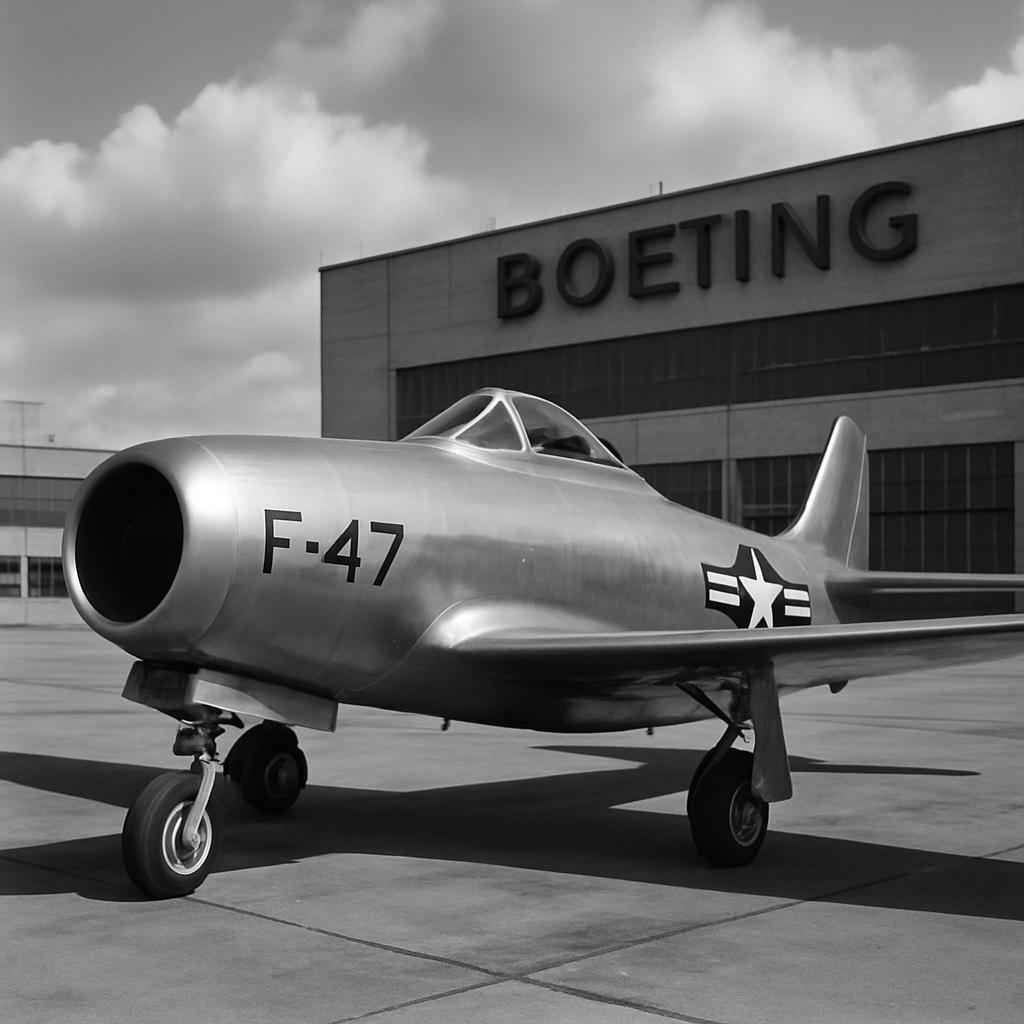“Boeing began production of the F-47 fighter jet for the United States.” That sentence turns up now and then in conversations, social feeds, and even in print — a tidy claim that sounds plausible until you start checking names, dates, and who actually built what. This article unpacks the reality behind that statement, traces the true history of the F-47 designation, reviews Boeing’s role in military aviation, and explores a grounded, informed hypothetical: what might have happened if Boeing had taken on production of that fighter.
- What was the F-47? The designation and its origin
- The Republic P-47: a short technical and operational sketch
- Boeing and fighters: what Boeing actually built
- Boeing’s wartime focus and industrial contributions
- Why Republic, not Boeing, built the Thunderbolt
- Procurement realities and industrial policy in wartime
- Tracing the myth: how the confusion arose
- Mergers, corporate memory, and the rewriting of lineage
- If Boeing had produced the F-47: a realistic what-if
- Manufacturing realities: tooling, jigs, and the slow work of production
- Would performance or tactics have changed under Boeing production?
- Supply chain and component sourcing
- Industrial and logistical outcomes of a production shift: bases, labor, and coastal geography
- The human element: skill, training, and factory culture
- Lessons about defense procurement and the modern relevance
- Why the past matters for the present
- Personal perspectives and museum visits: seeing the Thunderbolt up close
- Restoration work and the craft of preservation
- Comparative table: actual history vs. common myth vs. grounded hypothetical
- How to check claims like this: sources and archival research
- Practical steps for verification
- Why the precise history matters beyond trivia
- From myth to policy: the stakes of accuracy
- Closing thoughts and the value of careful curiosity
- Further reading and an invitation
What was the F-47? The designation and its origin
The designation “F-47” can create confusion because it sits on the border of two eras. During World War II the aircraft widely known as the P-47 Thunderbolt was a mainstay of U.S. Army Air Forces fighter and escort operations. In 1948, when the U.S. military reorganized and moved to a new designation system for fixed-wing combat aircraft, the “P” for pursuit became “F” for fighter, and the P-47 briefly became the F-47.
That administrative change did not mean a new airplane; it was a renaming of an existing platform. The Thunderbolt itself was designed and produced by Republic Aviation, and its wartime service record belongs to Republic-built machines. The historical record is clear: Republic, not Boeing, was the factory behind the Thunderbolt’s production lines during its service life.
The Republic P-47: a short technical and operational sketch
The P-47 (later F-47) Thunderbolt was notable for its large size, heavy armament, and robust radial engine, typically the Pratt & Whitney R-2800 Double Wasp. That engine gave the plane a combination of speed and durability that suited both high-altitude escort duty and low-level ground attack after the fighter role evolved during the war.
Operationally, the Thunderbolt earned a reputation for survivability. It could absorb combat damage and still return to base, and its eight .50-caliber machine guns made it a potent force against both air and ground targets. These qualities helped the P-47 play a major role in Allied air operations over Europe and the Pacific.
Boeing and fighters: what Boeing actually built
Boeing’s name is synonymous with American aviation, but that does not mean Boeing built every famous fighter. In the interwar years Boeing produced fighters such as the P-12 and the P-26 Peashooter. Those designs reflect Boeing’s early role in military aviation and its development of all-metal monoplane techniques that would influence later aircraft design.
Across the decades Boeing’s portfolio has been heavily weighted toward bombers, transport aircraft, and more recently complex systems for modern air combat and unmanned systems. Through corporate mergers and acquisition activity in the late 20th and early 21st centuries, Boeing’s footprint expanded into programs and competencies it previously had less direct involvement in, making the company one of the most diversified aerospace contractors in the United States.
Boeing’s wartime focus and industrial contributions
During World War II Boeing’s most visible contributions were in heavy aircraft such as the B-17 Flying Fortress and later the B-29 Superfortress. Those programs demanded massive factories, specialized tooling, and enormous supply chains to deliver thousands of aircraft under wartime urgency.
That level of industrial capacity gives context: building a fighter like the P-47 would not have been outside Boeing’s technical capabilities, but production decisions in wartime are influenced by many factors beyond capability alone.
Why Republic, not Boeing, built the Thunderbolt
Choosing a manufacturer in the 1930s and 1940s depended on design authorship, production capacity, government procurement timelines, and strategic decisions about who should focus on which class of aircraft. Alexander Kartveli and Republic Aviation had ownership of the Thunderbolt design; Republic had designed and refined the airframe and held production lines configured for that aircraft.
In wartime, the government often directed orders to specific firms based on specialization and the need to spread work across the industrial base. Republic had the design know-how and assembly plants ready for the Thunderbolt. Shifting production to another large firm would have required retooling, transferring technical data and jigs, and redirecting supply chains — all while under pressure to deliver planes to combat theaters.
Procurement realities and industrial policy in wartime
Procurement during World War II also emphasized speed and minimizing disruption. The War Department and Navy sought to maximize output by keeping designs where they were already in production, unless a bottleneck or capacity shortfall forced broader distribution of work. That practical stance reduces the plausibility of a wholesale Boeing takeover of Thunderbolt production, because such a shift would have been costly and slow.
Moreover, the U.S. government deliberately cultivated a diversity of manufacturers to avoid single points of failure. Keeping Republic in charge of the Thunderbolt helped maintain that balance.
Tracing the myth: how the confusion arose

Claims that “Boeing began production of the F-47 fighter jet for the United States.” likely arise from a few intersecting sources: the 1948 redesignation from P to F, the prominence of Boeing in American aerospace, and a tendency for corporate histories to blend through mergers and acquisitions. When companies merge or when heritage programs are absorbed into a larger corporate narrative, attributions can blur.
For example, later corporate consolidations placed many legacy programs under the umbrella of major contractors. That does not retroactively change who originally designed or produced a specific wartime aircraft, but it can muddy public understanding when people trace program lineage without digging into primary records.
Mergers, corporate memory, and the rewriting of lineage
When Airbus, Boeing, Lockheed, Northrop, and others acquire smaller firms or their assets, corporate histories and program catalogs often consolidate. This can create the impression that a modern company “built” historical aircraft that were actually produced by a predecessor or by an entirely different firm.
It’s a subtle shift, and it’s easy for casual references to become firm beliefs. That’s why careful archival work matters: contract documents, procurement orders, factory logs, and contemporary news coverage are the reliable guardrails against sloppy historical claims.
If Boeing had produced the F-47: a realistic what-if
Playing the counterfactual game carefully can illuminate how industry choices influence outcomes. If Boeing had taken on Thunderbolt production, the change would have involved tooling shifts, workforce retraining, and reallocation of supply chains for engines, airframes, and armament. The most immediate impact would probably have been on production rhythm and delivery schedules during a period of frantic demand.
It’s important to keep this hypothetical grounded: many of the Thunderbolt’s traits — its radial engine, large fuselage, and heavy armament — are tied to the design, not the builder. A different manufacturer could have produced functionally similar aircraft, but the production-rate curve, build quality nuances, and logistical footprints might have differed.
Manufacturing realities: tooling, jigs, and the slow work of production
Transitioning production to a new factory is not simply a matter of sending blueprints. Jigs, fixtures, patterns, and vendor relationships for subcomponents like landing gear, instrumentation, and armament all matter deeply. These elements require weeks to months to produce and align, and wartime urgency amplifies the cost of delay.
Boeing’s existing factories at the time were committed to heavy bomber lines, which would complicate any rapid transfer of a fighter program. Even if leadership had decided to move work, the short-term result could have been a dip in total output while new lines came up to speed.
Would performance or tactics have changed under Boeing production?
Manufacturing changes can affect operational outcomes, but aircraft performance is primarily a function of design and systems integration. The Thunderbolt’s combat tactics evolved because of its engine power, rugged construction, and ordnance capability, not because of the embossed logo on its elevator. A Boeing-built Thunderbolt would likely have performed similarly if it met the same engineering standards and used the same engines and weapon systems.
Where a different manufacturer could influence tactics is through production quantity and delivery timing. More aircraft delivered sooner could shift operational emphasis, allowing commanders to sustain escort missions more reliably or expand ground-attack sorties in a theater.
Supply chain and component sourcing
One crucial variable is engine production. The Pratt & Whitney R-2800 was a critical item for many wartime platforms, and its availability often limited aircraft output. If Boeing had concentrated more resources on the Thunderbolt, it might have pushed different priorities in engine allocation, which in turn could have altered the tempo of missions flown by U.S. forces.
Similarly, variations in vendor relationships for guns, radios, and other components could create small differences in field experience. Those differences seldom change an aircraft’s identity, but over many sorties they can affect maintenance cycles and squadron availability.
Industrial and logistical outcomes of a production shift: bases, labor, and coastal geography
Where aircraft are produced matters. Factories have regional workforces, supply bases, and transportation links that shape logistical efficiency. Republic’s plants were established for the Thunderbolt; a switch to Boeing production could have shifted jobs, altered local economies, and changed where spare parts were dispatched during operations.
In practice, such shifts influence training pipelines, depot repair facilities, and the placement of demonstration and acceptance flights. Reorienting these systems mid-war is possible but costly, and the Department of War generally preferred incremental expansion over wholesale restructuring.
The human element: skill, training, and factory culture
Each manufacturer develops a culture and skill set tailored to the types of aircraft it makes. A factory accustomed to bomber-scale assemblies will have different rhythms than a plant focused on single-seat fighters. Those cultural differences translate into approaches to quality control, inspection regimes, and incremental improvements during production runs.
If Boeing had taken on a fighter like the Thunderbolt, it might have borrowed best practices from bomber production — some of which could have enhanced survivability or maintainability — while needing to adapt to the high-mix, low-weight structures typical of fighters.
Lessons about defense procurement and the modern relevance
History shows that matching design, manufacturer, and government procurement policy is a complex dance. The story of the P-47 and the myth of a Boeing-built F-47 highlight a broader lesson: procurement decisions are a blend of engineering reality, industrial capacity, and strategic calculation.
Today, with global supply chains and consolidated defense firms, the issue is both more complex and more constrained. Large prime contractors now hold portfolios that span many legacy programs, yet the need to keep multiple suppliers healthy remains to avoid systemic failures in times of crisis.
Why the past matters for the present
Understanding who built what, and why, helps policymakers decide how to structure industrial policy and maintain readiness. If your history lessons are fuzzy, you risk repeating mistakes: overconcentration of production, failure to maintain critical vendor capacity, or slow response to emerging threats because of misaligned factories.
The P-47 story reminds us that choices made in peacetime—about which firms get which contracts, where plants are located, and how supply chains are supported—can have strategic consequences when conflict arrives.
Personal perspectives and museum visits: seeing the Thunderbolt up close
On a personal note, I’ve spent time at aviation museums staring at Thunderbolts on the tarmac, reading maintenance placards, and talking to volunteers who restore these machines. Seeing the thick fuselage, the massive engine cowling, and the battle scars on preserved airframes brings home the reality of what those aircraft had to endure.
Those museum visits are a reminder that aircraft are not just numbers in a manual. They are built by people, maintained by people, and flown by people, and each factory left its imprint on the machines it produced. The Republic-built Thunderbolts on display bear the hallmarks of their origin in ways that historians and enthusiasts can trace through construction details and archival records.
Restoration work and the craft of preservation
Volunteers restoring a Thunderbolt routinely encounter the literal fingerprints of history: rivet patterns, factory stamps, and parts numbers that map back to specific suppliers. These small artifacts form the chain of evidence that confirms which company produced which aircraft and why claims attributing production to other firms often fall apart under scrutiny.
Preservation also shows how design and manufacturing go hand in hand: restorers must understand original manufacturing practices to return a plane to airworthiness, which reinforces the value of accurate production records.
Comparative table: actual history vs. common myth vs. grounded hypothetical
The following table summarizes the distinctions between what happened, what is sometimes claimed, and a realistic what-if scenario.
| Item | Actual history | Common myth | Grounded hypothetical |
|---|---|---|---|
| Manufacturer | Republic Aviation | Boeing | Boeing produces Thunderbolts after major retooling and transfer of designs |
| Designation | P-47 during WWII; redesignated F-47 in 1948 | Often cited as “Boeing F-47” | Designation unchanged; a different builder produces the same design |
| Operational effect | Proven fighter/ground-attack aircraft with high survivability | Unclear—often implies Boeing-driven changes | Similar performance, different production rhythm and logistics |
How to check claims like this: sources and archival research

If you want to verify historical claims about aircraft production, primary sources are your best tools. Procurement contracts, government technical orders, factory correspondence, and contemporary press reports are the documentary backbone. Museums, national archives, and specialist aviation history organizations frequently provide access to these records.
Secondary sources such as reputable aviation histories are useful too, provided they cite primary documentation. Be cautious with blogs, forums, and social media posts that repeat claims without attribution; they are often where myths propagate.
Practical steps for verification
- Start with the aircraft designation and manufacturer’s name in official war-era procurement records.
- Consult contemporary issues of aviation periodicals and defense department bulletins for production announcements and factory deliveries.
- Visit museum restoration shops or contact curators who can often point to serial numbers and factory stamps that establish provenance.
- Use national archives or library collections to find contract awards, which typically name the winning firm and the scope of production.
Why the precise history matters beyond trivia
On the surface, whether Boeing or Republic built a specific aircraft might sound like a detail that matters only to historians. In practice, production lineage affects how veterans remember service, how museums attribute exhibits, and how modern industrial policy is shaped. It also matters for legal and intellectual-property reasons when programs and parts are claimed by successor companies.
Clear attribution preserves the integrity of historical memory and informs debates about how we structure industrial bases for future defense needs. Misattributions can lead to misplaced assumptions about capacity and capability when planners look at past outcomes to guide future decisions.
From myth to policy: the stakes of accuracy
When policymakers assume that a single firm handled a critical wartime task because of a mistaken historical claim, it can skew their view of supply chain resilience. Accurate histories help ensure that efforts to maintain domestic production capability rest on reality rather than on convenient narratives.
That is why aviation historians and archivists devote substantial effort to keeping the record straight: those records feed into planning and procurement decisions decades after the last rivet was driven.
Closing thoughts and the value of careful curiosity
The statement “Boeing began production of the F-47 fighter jet for the United States.” is an example of how a small misattribution can travel far. By checking the archival record, visiting preserved aircraft, and understanding procurement practice, we see that the Thunderbolt’s story belongs to Republic Aviation, even after the 1948 F/P redesignation shuffle.
That said, the counterfactual—imagining Boeing on Thunderbolt production lines—offers a useful lens for understanding how manufacturing choices affect wartime outcomes. It shows how supply chains, tooling, and workforce distribution shape what aircraft reach the front and when.
Further reading and an invitation
If this topic caught your interest, there’s more to explore about wartime production, industrial policy, and the evolution of fighter design. Museums, archival repositories, and well-sourced histories provide fertile ground for deeper study.
For other articles on technology and innovation that analyze aviation history, industry trends, and the intersection of policy and engineering, check out more content on our site: https://themors.com/technology-innovation-news/.









